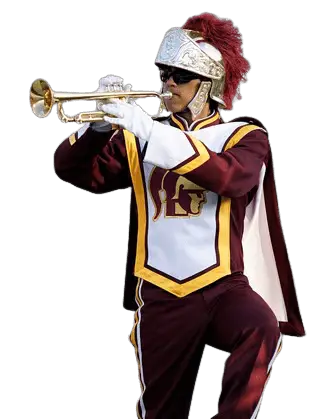Playing in a marching band is a rather different experience than playing in a typical school or concert band. On those last ones, every player is normally sit down or at least is playing in the same place.
Contrary to that, in a marching band and as the name suggests, the players are marching with their instruments while playing. Factors like the size and weight of the instrument do influence when looking to what are the easiest marching band instruments to play.
With so many different instruments you can play in a marching band, it’s difficult to identify exactly what are the easiest ones to play. We’ve identified already what are the easiest ones when you start to play in a typical band (in this article: easier instruments to play in a band).
Are those the same in a marching band?
The 5 Easiest Instruments to Play in a Marching Band
These are the instruments that could be considered as easier for someone playing in a marching band, however, do consider that this isn’t true for everyone and some players might disagree. We’ve considered the fact of how difficult is to learn the instrument itself and how difficult is to hold it for long periods while marching and playing at the same time.
First of all, and similar to what exactly happens to a typical band, you should know that marching bands are made of three groups of instruments: brass, woodwind, and percussion.
Within those, and if you haven’t chosen an instrument yet, make sure to choose an instrument that compliments your musical style as well as your physical characteristics.
The truth is that each instrument has its advantages and disadvantages.
If we had to choose, for each of the marching band instruments families, the easiest ones would be:
- Clarinet
- Saxophone
- Trumpet
- Cymbals
- Drum Bass

Saxophone 
Cymbals 
Drum Bass 
Trumpet 
Clarinet
What Marching Band Instrument Should I Play?
It depends on your skill level. If you are just starting, it may be easier to choose an easier one like the 5 ones we have detailed here.
If you are an experienced player, you will be able to pick out the one that best fits your skills and physical attributes.
Remember, the easier the instrument is to play, the more time you can devote to practicing before playing in public if you haven’t played in a marching band before.
Like playing in other types of bands, these instruments require a certain amount of musical ability and practice. There are many things that you need to do to be ready when you finally step up to play.
Your instructor will help you prepare by teaching you the basics and the different ways to play each instrument while marching.
After you have learned all of the information above, the hardest thing will probably be choosing which of the three main types of instruments will you be playing. Be sure to choose one that you feel most comfortable with.
You may find that playing one of these instruments will become a favorite of yours. This will happen if you enjoy the instrument, the music, and the atmosphere of the marching band.
There are many more options out there, just as there are many types of bands.

(c) Lynn Monson 2010
Get Counseling When in Doubt
If you are having trouble choosing the right marching band instrument, then seek counseling from the band leader, director, or music professor with experience in band instruments as well as marching bands.
This can be very helpful, especially if you are not sure about what can you play and don’t have much previous experience (although it is quite probable that for starting in a marching band you have had already some years of practice with some school band instruments).
They can teach you about various techniques, as well as recommend you appropriate equipment necessary to play in a marching band.
